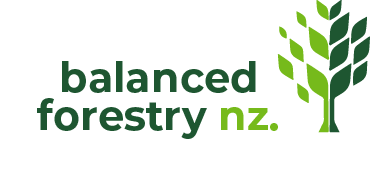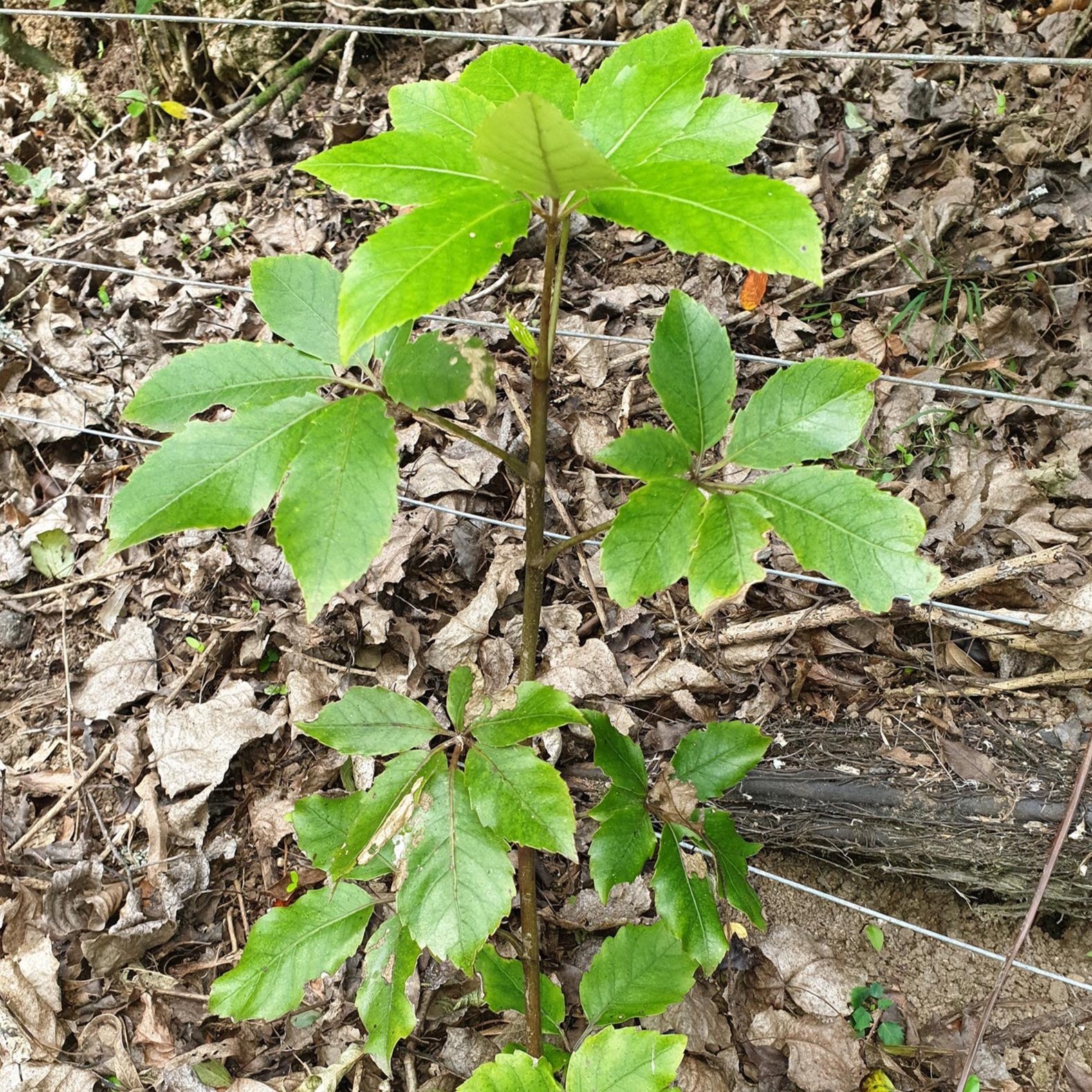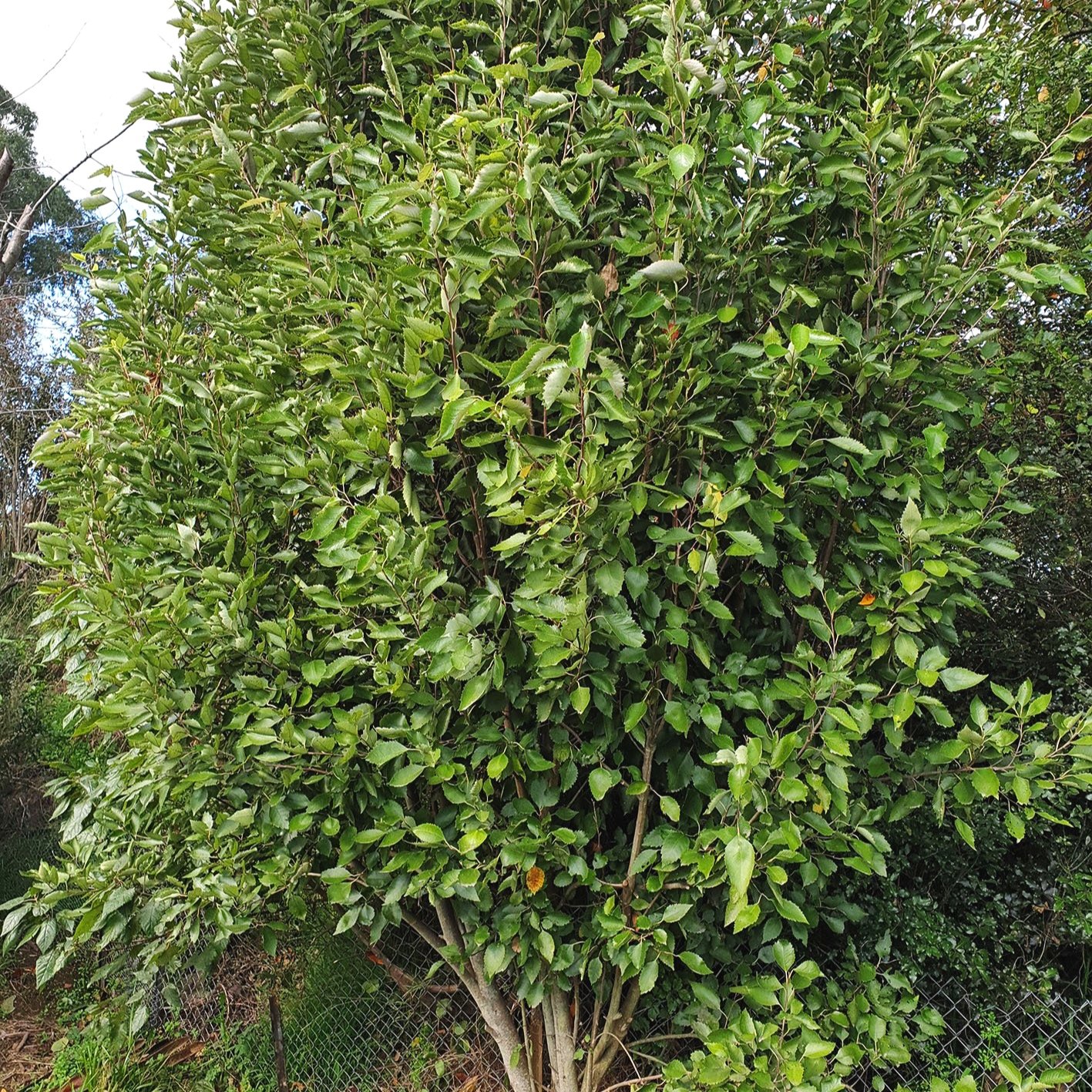Available plant species

Superior-quality seedlings.
Balanced Forestry has adopted traditional forestry techniques and commercial cultivation protocols that significantly lower the cost of native and select exotic species while dramatically improving establishment efficiency. This means our forestry species are cheaper and easier and quicker to put in the ground.
Our plants grow in a wide range of environmental conditions and we ship throughout New Zealand.
Suitable species table.
We have created the below table to help you navigate the best plant choices for your land and desired outcomes. Scroll down to read more about specific species and contact us today to discuss which species will work best for your land.
Bronwyn Douglas - 027 666 6863
info@balancedforestry.co.nz
Click here to download an A3 PDF of our Suitable Species table
Species descriptions.
Tōtara
Podocarpus totara
-
Tōtara isa non-flowering conifer tree that has small red fruit that grow under a green, black seed. It grows up to 30 in height and is common throughout the North and South Island in lowland forests. Regarded as a hardy pioneering species, Tōtara establishes well on open sites including amongst sparse weedy grass cover and is more tolerant of dry soils and seasonal drought than other podocarps. Tōtara is typically found on the less productive slopes in pastoral hill country, as well as along riparian areas, where it provides shading that is crucial to water quality enhancement.
-
Large Tree
Carbon
Timber
Bee Feed
Hill Country
Sediment Control
Erosion
Tawhairaunui
Red Beech
Fuscospora fusca
-
Is the largest and fastest growing of the beech species growing up to 30 meters in height and yields a strong, durable native hardwood timber. Red beech prefers well drained fertile soils of lower to mid slopes, valley floors and river terraces, this species grows both in the cooler areas of the North and South Island. It tolerates cold and drought and will grow to altitudes of 1,000 meters. Red beech generates honeydew, which is favoured by bees and many native birds.
-
Large Tree
Carbon Timber
Bee Feed
Hill Country
Sediment Control
Erosion
Tawhairauriki
Black Beech
Fuscospora solandri
-
Black beech is a strong, durable hardwood that is found in cool forests from the Bay of Plenty to northern Canterbury. It is a relatively fast-growing tree compared with other native species, reaching up to 30 metres high and up to 1 m in diameter. It tolerates cold and drought and will grow to altitudes of 600-700 m.
-
Large Tree
Carbon
Timber
Bee Feed
Hill Country
Sediment Control
Erosion
Tawhairauriki
Mountain Beech
Nothofagus cliffortioides
-
Grows in the central mountains of the North Island and South Island in in mountainous regions at high altitudes. Mountain beech grows to around 20 metres and is a durable hardwood timber that grows in less fertile soils and has masses of tiny, red flowers in spring.
-
Large Tree
Carbon
Timber
Hill Country
Sediment Control
Erosion
Bee Feed
Tawai
Silver Beech
Lophozonia menziesii
-
Silver beech favours higher, wetter conditions and is found in cool areas from the Bay of Plenty to the bottom of Southland. It is a relatively slow growing tree, reaching up to 30 m high and up to 2 m in diameter. Silver Beech tolerates cold and will grow to altitudes of 1200 m.
-
Timber
Large Tree
Carbon
Bee Feed
Hill Country
Sediment Control
Erosion
Kahikatea
NZ White Pine
Dacrycarpus dacrydioides
-
Kahikatea grows throughout New Zealand and is commonest in riverine and swamp forests. It is a hardy pioneering species and establishes easily in moist sites. Kahikatea loves light and grows particularly well in open areas and has a prolific production of fruit which attracts pigeons and tui. Kahikatea grows into a very large tree, up to 60 metres tall and 1.5 metres in diameter, making it a great species for carbon sequestration.
-
Riparian
Carbon
Honey
Sediment Control
Erosion
Wetland
Mānuka
Tea Tree
Leptospermum scoparium
-
Mānuka, a scrub-type tree, is New Zealand’s main pioneer shrub that can grow up to 10 meters in the right place. Can be grown in most areas of the North and South Island lowland to low alpine regions up to 1800 m above sea level. It can be found in many different habitats including wetlands, river gravels and dry hillsides. It produces flowers that can range from pink through to white from September through to February. When mature, it is very tolerant of drought, waterlogging, strong winds and frost, and it can grow at less fertile, colder, wetter and more acidic sites than kānuka. It is great for creating low shelter belts, screening, riparian planting, carbon, and specific varieties are suitable for honey and oil production.
-
Riperian
Carbon
Honey
Sediment Control
Erosion
Wetland
Attracts Nectar Feeding Birds
Whauwhaupaku
Five finger
Pseudopanax arboreus
-
Five finger is an evergreen, small bushy tree with multi branches and glossy green fleshy toothed leaves arranged in fans of 5 and sometimes 7 leaflets. Five Finger can reach up to 8 meters in height and grows very well in the North and South Island. The foliage becomes adorned with clusters of tiny white flowers during winter which result in purple black berries in summer that attract birds. It also produces an abundance of pollen early in the season before any other trees are flowering. It grows best in full sun or shade on a well-drained site and will tolerate coastal conditions, frost, shade, and poor soils.
-
Riperian
Carbon
Bee Feed
Erosion
Wetland
Hill Country
Sediment Control
Attracts Berry & Nectar Feeding Birds
Tarata
Lemonwood
Pittosporum eugenioides
-
Lemonwood is an evergreen tree that can grow up to 12 m tall and 5 m wide. It is conical when young but more rounded in shape when mature. Its leaves are mottled yellow green with curly edges which have a strong lemony smell when crushed. It has highly fragrant clusters of attractive yellow-cream flowers in spring, followed by distinctive black seed capsules. It is found throughout New Zealand's North and South Islands along forest margins and stream banks from sea level to 600m and is New Zealand's largest Pittosporum. Hardy and fast growing, Lemonwood can be used for bee feed, carbon, riparian planting or to provide a shelter belt between neighbouring properties.
-
Riperian
Carbon
Bee Feed
Sediment Control
Erosion
Wetland
Attracts Berry & Nectar Feeding Birds
Kōhūhū
Black matipo
Pittosporum Tenuifolium
-
Found throughout much of New Zealand, Kōhūhū is distinguished by dark grey branchlets and pale leaves with a wavy edge. Its flowers are nearly black and emit a sweet perfume at night. Kōhūhū grows up to 10 metres in height and is well spread all over New Zealand except for the Southern Alps and Stewart Island. Kōhūhū is a hardy plant that can cope with poor conditions such as poor soils, droughts, and windy environments. This makes it suitable for most areas but especially coastal, riparian, and lower mountain forest areas up to an altitude of 900 m.
-
Riperian
Carbon
Honey
Sediment
Erosion
Wetland
Bee feed
Attracts Berry & Nectar feeding Birds
Karamū
Coprosma
Coprosma Robusta
-
It all begins with an idea. Maybe you want to launch a business. Maybe you want to turn a hobby into something more.
-
Riparian
CarbonBee Feed
Sediment Control
Attracts Berry & Nectar feeding Birds
Erosion
Wetland
Hoheria
Lacebark
Hungere
-
Lacebark is a large, evergreen tree that can grow up to 10 meters in height. Lacebark grows quickly, produces large clusters of white flowers and is frost tolerant. Commonly found in coastal regions both on the North and South Islands, Lacebark grows well in exposed areas and in sandy and loamy soil conditions. This is a hardy plant suitable for bee feed, carbon, riparian and restoration areas.
-
Riparian
Carbon
Bee Feed
Hill Country
Sediment Control
Erosion
Attracts Berry & Nectar feeding Birds
Makomako
Wineberry
Aristotelia serrata
-
Wineberry is a small deciduous fast-growing tree or shrub, which can reach up to 10m in height, and 30 cm in diameter. Wineberry produces light green leaves and flowers of all shades from cream coloured, through to pink to dark red. Endemic to New Zealand, wineberry is found throughout the South Island of New Zealand and lower North Island. It is common in moist forests and scrubland within the lowland, montane, and sub-alpine climates.
-
Riperian
Carbon
Honey
Sediment
Erosion
Wetland
Bee Feed
Attracts Berry & Nectar feeding Birds
Ti kouka
Cabbage tree
Cordyline australis
-
Cabbage tree is a very distinctive tree with highly architectural foliage and grows up to 20m in height. It has strongly scented white flowers which readily attract birds and bees.
Cabbage tree is endemic and widespread throughout New Zealand from coastal to montane areas and is mostly associated with riparian forest as it loves damper soils.
-
Riparian
Carbon
Bee Feed
Coastal
Sediment Control
Wetland
Attracts Berry & Nectar feeding Birds
Akeake
Hopbush
Dodonaea viscosa
-
A bushy shrub or small tree that grows up to 12 meters in height and is characterised with flaky reddish bark and bearing long thin wavy leaves. Found throughout New Zealand, as well as the Chatham Islands. Akeake thrives in poor conditions such as dry, depleted, or sandy soil, and the harsher the conditions the more vibrant the colours seem to be enhanced in these trees.
-
Riparian
Carbon
Coastal
Hill Country
Erosion
Kānuka
Kunzea ericoides
-
Kānuka is found throughout the North and South Islands growing up to 20 meters in height. Kānuka is extremely hardy and grows well in coastal to lowland shrubland, regenerating forest and forest margins, also present in montane forest, shrubland and very occasionally present in subalpine shrubland. It acts as a nurse plant for many species especially kauri and Podocarps and, being light demanding, is eventually replaced by these species. Branches often pendent at ends, bearing masses of needle-like bright green leaves and clusters of small white flowers.
-
Riperian
Carbon
Honey
Sediment
Erosion
Wetland
Attracts Nectar Feeding Birds
Harakeke
Flax
Phormium tenax
-
A hardy, clump-forming evergreen perennial growing to around 3m tall with flower spike and 2m wide. Harakeke has olive-coloured leaves up to 3m long are held in fan-like rows. Red-yellow-pink flowers from spring to summer and seeds from summer to autumn. The rich nectar is attractive to bees and native birds. Harakeke is tolerant of a wide range of conditions and does particularly well in wetland areas. It is frost hardy.
-
Riparian
Bee Feed
Sediment control
Erosion
Wetland
Attracts Berry & Nectar Feeding Birds
Mahoe
Whiteywood
Melicytus ramiflorus
-
Mahoe grow up to 15 meters in height and has a smooth whitish bark. The berries are eaten by several native birds, including kererū and tui, while geckos have also been known to eat them. This tree grows fast and does well in coastal, lowland and lower montane forests both in the North and South Island.
-
Riparian
Carbon
Wetland
Attracts Berry Feeding Birds
Eucalyptus
Eucalyptus
-
A fast-growing, attractive tree with furrowed bark & silver leaves. Small white flowers in winter make it a good nectar producer for birds & bees. Cut foliage is valued in floral work. Different species will tolerate wet or dry conditions, salt winds and frost. Retains lower branches to near ground level, making an ideal screen or windbreak. Evergreen. Hardy.
Eucalyptus species are large, fast-growing trees that produce high volumes of wood in short duration. Excellent as a carbon species, and some as timber for building construction. Eucalyptus should be site matched as it responds differently to site, climate and presents of pests, it grows well in a range of soil types and environmental conditions; Eucalyptus nitens, for example, is frost tolerant and well suited to cooler climates; Eucalyptus fastigata grows well in moist soils.
Eucalyptus can easily reach heights of between 30-50m.
-
Large Tree
Carbon
Timber
Honey
Bird Attractor
Bee Feed
Hill Country
Erosion
Redwood
Sequoia sempervirens
-
Redwood are a versatile species that produce their best timber on sheltered, inland sites. They perform best in well-drained, fertile soils, with regular rainfall; frosty and water-logged sites are best avoided. Redwood grow rapidly in New Zealand and live for a long time making them ideal for carbon sequestration and erosion control, as they are long-lived. Redwood is very wind-firm and the collapse of older stands that is seen in other commonly grown softwoods is rare in redwood stands. Redwood trees are also naturally fire resistant due to their thick fibrous bark. The risk of liabilities arising as trees storing carbon burn or blow over is relatively small. Redwood is a light, durable timber with a range of indoor and outdoor end uses including weatherboards, decking, outdoor furniture and indoor joinery.
Redwoods can easily reach heights over 35m with diameters of over 65cm at 50 years and reach heights of over 70m at 100 years.
-
Large Tree
Carbon
Timber
Hill Country
Erosion



















